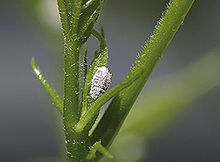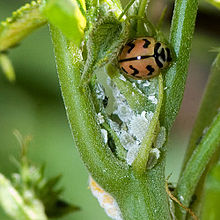- Mealybug
-
Mealybugs 
Maconellicoccus hirsutus, the pink hibiscus mealybug Scientific classification Kingdom: Animalia Phylum: Arthropoda Class: Insecta Order: Hemiptera Suborder: Sternorrhyncha Family: Pseudococcidae
Heymons, 1915 [1]Genera See text [2]Mealybugs are insects in the family Pseudococcidae, unarmored scale insects found in moist, warm climates. They are considered pests as they feed on plant juices of greenhouse plants, house plants and subtropical trees and also acts as a vector for several plant diseases.
Contents
Distribution
Mealybugs occur in all parts of the world. They are a large number of species in the Palearctic ecozone and fewer in the Neotropic ecozone.
Description
 Formica fusca ants tending a herd of mealybugs.
Formica fusca ants tending a herd of mealybugs.
Mealybugs are sexually dimorphic, meaning that the sexes have distinct morphological differences. Females are nymphal, exhibit reduced morphology, and are wingless, though unlike many female scale insects, they often retain legs and can move. The females do not change completely and are likely to be neotenic (exhibiting nymphal characteristics). Males are winged and do change completely during their lives. Since mealybugs (as well as all other Hemiptera) are hemimetabolous insects, they do not undergo complete metamorphosis in the true sense of the word, i.e. there are no clear larval, pupal and adult stages, and the wings do not develop internally. However, male mealybugs do exhibit a radical change during their life cycle, changing from wingless, ovoid nymphs to "wasp-like" flying adults.
Mealybug females feed on plant sap, normally in roots or other crevices. They attach themselves to the plant and secrete a powdery wax layer (therefore the name mealybug) used for protection while they suck the plant juices. The males on the other hand, are short-lived as they do not feed at all as adults and only live to fertilize the females. Male citrus mealy bugs fly to the females and resemble fluffy gnats.
Some species of mealybug lay their eggs in the same waxy layer used for protection in quantities of 50–100; other species are born directly from the female.
The most serious pests are mealybugs that feed on citrus; other species damage sugarcane, grapes, pineapple (Jahn et al. 2003), coffee trees, cassava, ferns, cacti, gardenias, papaya, Mulberry, sunflower and orchids. Mealybugs only tend to be serious pests in the presence of ants because the ants protect them from predators and parasites. Mealybugs also infest some species of carnivorous plant such as Sarracenia (pitcher plants), in such cases it is difficult to eradicate them without repeated applications of insecticide such as diazinon. Small infestations may not inflict significant damage. In larger amounts though, they can induce leaf drop.
Fossil specimens of Acropyga genus ants have been recovered from the Burdigalian stage Dominican amber deposits and several individuals are preserved carrying the extinct mealybug genus Electromyrmococcus.[3] These fossils represent the oldest recorded record of the symbiosis between mealybugs and Acropyga species ants.[3]
Genera
- Acaciacoccus
- Acinicoccus
- Acrochordonus
- Adelosoma
- Agastococcus
- Albertinia
- Allomyrmococcus
- Allotrionymus
- Amonostherium
- Anaparaputo
- Anisococcus
- Annulococcus
- Anthelococcus
- Antonina
- Antoninella
- Antoninoides
- Apodastococcus
- Artemicoccus
- Asaphococcus
- Asphodelococcus
- Asteliacoccus
- Atriplicicoccus
- Atrococcus
- Australicoccus
- Australiputo
- Balanococcus
- Bessenayla
- Bimillenia
- Birendracoccus
- Boninococcus
- Boreococcus
- Bouhelia
- Brasiliputo
- Brevennia
- Brevicoccus
- Callitricoccus
- Calyptococcus
- Cannococcus
- Capitisetella
- Cataenococcus
- Chaetococcus
- Chaetotrionymus
- Chileputo
- Chlorococcus
- Chnaurococcus
- Chorizococcus
- Chryseococcus
- Cintococcus
- Circaputo
- Cirnecoccus
- Clavicoccus
- Coccidohystrix
- Coccura
- Coleococcus
- Colombiacoccus
- Conicosoma
- Conulicoccus
- Coorongia
- Cormiococcus
- Criniticoccus
- Crisicoccus
- Crocydococcus
- Cryptoripersia
- Cucullococcus
- Cyperia
- Cypericoccus
- Cyphonococcus
- Dawa
- Delococcus
- Delottococcus
- Densispina
- Discococcus
- Distichlicoccus
- Diversicrus
- Drymococcus
- Dysmicoccus
- Eastia
- Ehrhornia
- Electromyrmococcus
- Epicoccus
- Erimococcus
- Eriocorys
- Erioides
- Erium
- Eucalyptococcus
- Eumirococcus
- Eumyrmococcus
- Eupeliococcus
- Euripersia
- Eurycoccus
- Exilipedronia
- Farinococcus
- Ferrisia
- Ferrisicoccus
- Fijicoccus
- Fonscolombia
- Formicococcus
- Gallulacoccus
- Geococcus
- Glycycnyza
- Gomezmenoricoccus
- Gouxia
- Greenoripersia
- Grewiacoccus
- Hadrococcus
- Heliococcus
- Heterococcopsis
- Heterococcus
- Heteroheliococcus
- Hippeococcus
- Hopefoldia
- Humococcus
- Hypogeococcus
- Iberococcus
- Idiococcus
- Indococcus
- Inopicoccus
- Ityococcus
- Kenmorea
- Kermicus
- Kiritshenkella
- Lachnodiella
- Lachnodiopsis
- Lacombia
- Laingiococcus
- Laminicoccus
- Lankacoccus
- Lantanacoccus
- Lenania
- Leptococcus
- Leptorhizoecus
- Liucoccus
- Lomatococcus
- Londiania
- Longicoccus
- Maconellicoccus
- Macrocepicoccus
- Maculicoccus
- Madacanthococcus
- Madagasia
- Madangiacoccus
- Madeurycoccus
- Malaicoccus
- Malekoccus
- Mammicoccus
- Marendellea
- Mascarenococcus
- Maskellococcus
- Mauricoccus
- Melanococcus
- Metadenopsis
- Metadenopus
- Miconicoccus
- Mirococcopsis
- Mirococcus
- Miscanthicoccus
- Misericoccus
- Mizococcus
- Mollicoccus
- Mombasinia
- Moystonia
- Mutabilicoccus
- Nairobia
- Natalensia
- Neochavesia
- Neoclavicoccus
- Neoripersia
- Neosimmondsia
- Neotrionymus
- Nesococcus
- Nesopedronia
- Nesticoccus
- Nipaecoccus
- Novonilacoccus
- Octococcus
- Odacoccus
- Ohiacoccus
- Oracella
- Orococcus
- Orstomicoccus
- Oxyacanthus
- Palaucoccus
- Palmicultor
- Paludicoccus
- Pandanicola
- Papuacoccus
- Paracoccus
- Paradiscococcus
- Paradoxococcus
- Paraferrisia
- Paramococcus
- Paramonostherium
- Paramyrmococcus
- Parapaludicoccus
- Parapedronia
- Paraputo
- Pararhodania
- Paratrionymus
- Parkermicus
- Paulianodes
- Pedrococcus
- Pedronia
- Peliococcopsis
- Peliococcus
- Pellizzaricoccus
- Penthococcus
- Peridiococcus
- Phenacoccus
- Phyllococcus
- Pilococcus
- Planococcoides
- Planococcus
- Pleistocerarius
- Plotococcus
- Poecilococcus
- Polystomophora
- Porisaccus
- Porococcus
- Prorhizoecus
- Prorsococcus
- Pseudantonina
- Pseudococcus
- Pseudorhizoecus
- Pseudorhodania
- Pseudoripersia
- Pseudotrionymus
- Puto
- Pygmaeococcus
- Quadrigallicoccus
- Rastrococcus
- Renicaula
- Rhizoecus
- Rhodania
- Ripersia
- Ritsemia
- Rosebankia
- Saccharicoccus
- Sarococcus
- Scaptococcus
- Seabrina
- Serrolecanium
- Seyneria
- Spartinacoccus
- Sphaerococcus
- Spilococcus
- Spinococcus
- Stachycoccus
- Stemmatomerinx
- Stipacoccus
- Strandanna
- Stricklandina
- Strombococcus
- Synacanthococcus
- Syrmococcus
- Tangicoccus
- Tasmanicoccus
- Telocorys
- Tibetococcus
- Tomentocera
- Trabutina
- Tridiscus
- Trimerococcus
- Trionymus
- Trochiscococcus
- Turbinococcus
- Tylococcus
- Tympanococcus
- Ventrispina
- Villosicoccus
- Volvicoccus
- Vryburgia
- Xenococcus
- Yudnapinna
See also
- Maconellicoccus hirsutus - pink hibiscus mealybug, grape mealybug
- Paracoccus marginatus - papaya mealybug
- Phyllococcus oahuensis
- Planococcus citri - citrus mealybug
- Pseudococcus viburni - obscure mealybug
References
- ^ "Pseudococcidae Heymons, 1915". Integrated Taxonomic Information System. http://www.itis.gov/servlet/SingleRpt/SingleRpt?search_topic=TSN&search_value=109211.
- ^ Encyclopedia of Life
- ^ a b Johnson, M.S.; et al (2001). "Acropyga and Azteca Ants (Hymenoptera: Formicidae) with Scale Insects (Sternorrhyncha: Coccoidea): 20 Million Years of Intimate Symbiosis". American Museum Novitates 3335: 1–18. doi:10.1206/0003-0082(2001)335<0001:AAAAHF>2.0.CO;2.
Further reading
- Jahn, G. C. and J.W. Beardsley 1994. Big-headed ants, Pheidole megacephala: Interference with the biological control of gray pineapple mealybugs. In D.F. Williams [ed.] "Exotic Ants: Biology, Impact and Control of Introduced Species." Westview Press, Oxford, 199-205.
- Jahn, G. C. and J.W. Beardsley 1998. Presence / absence sampling of mealybugs, ants, and major predators in pineapple. J. Plant Protection in the Tropics 11(1):73-79.
- Jahn, Gary C., J. W. Beardsley and H. González-Hernández 2003. A review of the association of ants with mealybug wilt disease of pineapple. Proceedings of the Hawaiian Entomological Society. 36:9-28.
External links
- NCIPM (National Centre for Integrated Pest Management) - Cotton Mealybugs
- BBC gardening advice, mealybugs
- CISR - Vine Mealybug Center for Invasive Species Research summary on Vine Mealybug
On the University of Florida / Institute of Food and Agricultural Sciences Featured Creatures website:
Categories:- Scale insects
- Agricultural pest insects
- Insect pests of ornamental plants
- Insect vectors of plant pathogens
Wikimedia Foundation. 2010.


